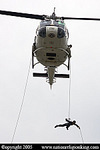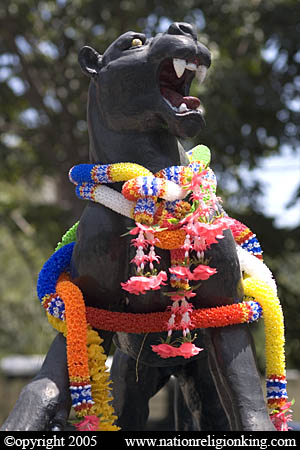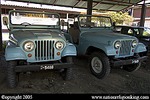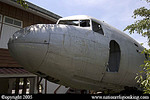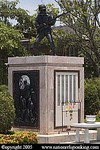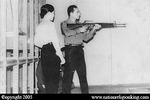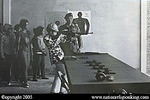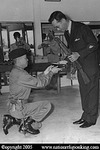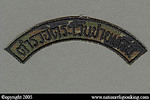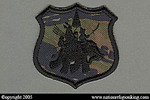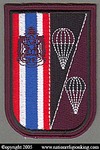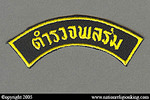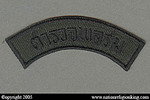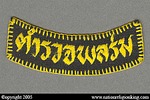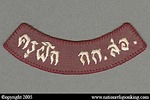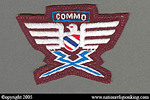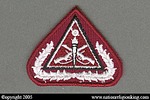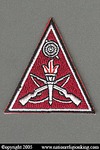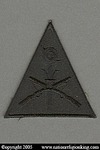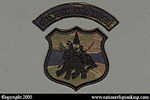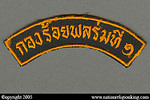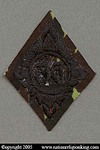| Thailand: Nation, Religion, King | |||||||
| Royal Thai Police | Royal Thai Military | Contact | |||||
| HOME -> ROYAL THAI POLICE -> BORDER PATROL POLICE -> PARU |
|
Border Patrol Police Aerial Reinforcement Unit MISSION (ภารกิจ) | ||
|
The Border Patrol Police Aerial Reinforcement Unit (BPP PARU) is a special warfare unit responsible for training and supporting airborne operations, airborne reinforcement, disaster and accident rescue, and supporting special missions under the command of the Border Patrol Police. |
กองกำกับการสนับสนุนทางอากาศ ตำรวจตระเวนชายแดน มีหน้าที่ เป็นกำลังสนับสนุน ในการปฏิบัติการสงครามพิเศษ ฝึกอบรม และ ปฏิบัติการสนับสนุน การยุทธส่งทางอากาศ การยุทธเคลื่อนที่ทางอากาศ การส่งกำลังทางอากาศ ช่วยเหลือผู้ประสบภัย และ สนับสนุน การปฏิบัติภารกิจพิเศษ ตามคำสั่งกองบัญชาการ ตำรวจตระเวนชายแดน และ กรมตำรวจ | |
|
ABILITY (ขีดความสามารถ) | ||
|
All members of PARU are trained for airborne operations including free-fall jumps. PARU conducts training for unconventional warfare, international counter-terrorism prevention, and parachute training of members of the Royal Thai Police. Training for disaster and accident rescue on land and water including sea air rescue. Ready to support any subdivision of the Border Patrol Police General Headquarters within a 2 hour alert. On alert to conduct special missions under the command of The Border Patrol Police General Headquarters and Royal Thai police at anytime. Charged by the Royal Thai Police with the duty of preventing and suppressing international terrorism. |
เคลื่อนที่ทางอากาศ และ กระโดดร่มได้ทั้งหน่วย หากได้รับการสนับสนุนอากาศยาน ฝึกอบรมการรบนอกแบบ การต่อต้าน การก่อการร้ายสากล และ นักโดดร่มกรมตำรวจ ปฏิบัติการช่วยเหลือ ผู้ประสบภัยทั้ง ทางบก ทางน้ำ และ ทางอากาศ ได้อย่างรวดเร็ว สนับสนุน หน่วยปฏิบัติระดับ กองกำกับการ ตำรวจตระเวนชายแดน ได้ครั้งละ 1 กองร้อยรบพิเศษ และพร้อมที่จะ ไปปฏิบัติงานได้ ภายใน 2 ชั่วโมง นับแค่รับคำสั่งให้ปฏิบัติ ปฏิบัติภารกิจพิเศษ ตามคำสั่งของกองบัญชาการ ตำรวจตระเวนชายแดน และ กรมตำรวจได้ตลอดเวลา ปฏิบัติภารกิจ ป้องกันและปราบปราม การก่อการร้ายสากลของ กรมตำรวจ | |
| HISTORY | ||
|
FOUNDING Following the end of WWII, there was great concern of a Chinese invasion of South-East Asia. Pro-communist radio broadcasts directed at the Thai Government were being heard over the radio in Bangkok. The remains of the anti-communist Nationalist Chinese forces has already fled into Burma and Northern Laos. Because of this fear, a decision was made by the United States government to support the staunchly anti-communist Thai Field Marshal Phibun Songkram.
As part of this support, the newly opened CIA station in Bangkok worked with the Thai government to form contingency plans in case of a Chinese invasion. Part of these plans involved the creation of a local guerrilla force. A choice was made to use the Thai Police as the source for these guerrilla fighters since the Thai Police were viewed as more flexable than the Royal Thai Army. In addition, Thai Police were already distributed around the country and could provide a faster reaction to events than the Thai Military. Strong support for the plans was given by the Director-General of the Thai National Police Department, General Phao Siyanon. The CIA assigned James William 'Bill' Lair to work with the Thai Police on the project. An American front company, Southeast Asia Supply Company, or Sea Supply, was also created to administer the training programs. LOPBURI YEARS The initial training base was setup at an abandoned Japanese military camp in Lopburi. A course was created consisting of 8 weeks of training in parachuting and unconventional warfare tactics. The original 50 trainees were recruited from the Thai Police but later recruits came from the Army, Navy, and Air Force. The graduates from this course became the Territorial Defense Police, later to be known as the Thai Border Patrol Police. At the end of 1953, 94 Border Patrol Police platoons, each averaging 45 men, had been trained by Sea Supply and deployed along the Thai Borders. By 1953, the threat from China started to diminish. Pressure was put on General Phao to turn over control of the training camp in Lopuri, which had become known as Camp Erawan, to the Royal Thai Army. Bill Lair's guerrilla project had taken on a life of its own from the larger Border Patrol Police training and there was also pressure to shut down this training since it was viewed to be no longer needed. With the threat of being disbanded, Bill Lair proposed turning the guerrilla force into an elite special operations unit. A proposal was written up by him and after finding initial support with the United States Embassy in Bangkok, was presented personally by Bill Lair to General Phao. Suprisingly, General Phao fully supported the idea and insisted that Bill Lair become a member of the Thai Police and personally lead the unit. EARLY HUA HIN YEARS With his new support, in 1953, Bill Lair started transforming the guerrilla force into a commando unit trained for offensive, defensive, and cross-border missions. A selection process was begun and fifty of the best police graduates were chosen as the core of the unit. They were in turn asked to select an additional fifty members. Since Lopburi was no longer available, a new location had to be picked. Hua Hin was picked becuase of its central Thailand location and also because it allowed training to be conducted in various types of terrain including the jungle, mountains, and the beach. The King of Thailand, His Royal Majesty King Bhumibol Adulyadej, had a Summer Palace in Hua Hin and there was guard quarters across the street from it. It was decided to build another barracks at this same location to house the new unit and also a headquarters building. As an added benefit, the location gave them easy access to the King in case of a crisis. In an emergency, if the King could not get to a safe location, the unit could act as a personal bodyguard. An additional training location for jungle warfare was found west of Hua Hin closer to the Burma border. Getting to the training base required a week long trek from Hua Hin. The training course was set up to last at least 60 days which consisted of training in jungle warfare and survival. Small units were organized into nine man squads broken into three man fire teams. Basic tactics were taught including how to perform ambushes. Initial weapons were supplied by the United States and consisted of a few M1 rifles and M1 carbines, a few mortars, bazookas, and grenade launchers. The location also gave the unit its first experience with the many ethnic minorities in South-East Asia, in this case Karen villagers. By 1957, the unit consisted of two rifle companies and a pathfinder company which was commanded by Lair himself, at this time a Captain in the Thai Police. In September, 1957, a coup was mounted by the Royal Thai Army Commander Sarit Thanarat. General Phao was forced into exile and since the unit was viewed as loyal to Phao, it was targeted for disbandment. Border Patrol Police Commander, Special Colonel Charn Angsuchote was able to negotiate a temporary compromise with Sarit that would leave the unit intact if they agreed to disarm. All weapons and parachutes were collected from the unit and taken to Bangkok. During this period the unit concentrated on unarmed combat. They also spent their spare time in Hua Hin performing civil service duties such as sweeping the streets. A newspaper article written by a close friend of the King appeared in the press commenting on the good work the members of the unit were doing in Hua Hin. This was taken as a sign that the King supported the unit and shortly after, their weapons and parachutes were returned. In 1958, the unit made a deal with Sarit. They would change their name to the Police Aerial Reinforcement Unit (PARU) and agree to be integrated into the Royal Thai Army. Their headquarters would also be changed to Phitsamulok in Northern Thailand. Because PARU was involved in US sponsored Cold War activities, Sarit decided to let them temporarily remain under the control of the Thai Police until a plan could be created to bring them under proper control of the Thai Army. During this time, Lair as well as the other PARU Officers went through US Army Ranger Training at Fort Benning, Georgia, and also received advanced courses in company and battalion tactics. PARU's Pathfinder Company had been sent to the Thai border in the early 1960 to collect data on the many minority tribes living along the border with Laos. Because these groups lived on both sides of the border, permission was granted by Lao General Phoumi for PARU to have free access to cross the border at will. In August, 1960, a coup took place in Vientiane, Laos, which would once again change the future of PARU. CREDITS Oral History Interview with Bill Lair, The Vietnam Project, Texas Tech University Shadow War: The CIA's Secret War in Laos, Kenneth Conboy with Hames Morrison. Shooting At The Moon: The Story of America's Clandestine War In Laos, Roger Warner. | ||
| LINKS | |
|
http://www.geocities.com/bpp_92/ Border Patrol Police Subdivision 92 (PARU) [Thai] | |
|
http://www.vietnam.ttu.edu/oralhistory/Transcripts/Lair_Bill.htm Interview with Bill Lair about the founding of the Thai Border Patrol Police (BPP) and Police Airborne Reinforcement Unit (PARU). [English] | |
|
http://www.geocities.com/thaipolairborne/ Border Patrol Police Airborne Reinforcement Unit (PARU). [Thai] | |
|
http://www.nationreligionking.com/police/borderpatrol/paru/naresuan261/ Naresuan 261 Special Ops Unit [English] | |
|
http://www.geocities.com/thaipolairborne/n261.htm Naresuan 261 Special Ops Unit website with information and history. [Thai] | |
|
http://www.nationreligionking.com/police/borderpatrol/paru/seaairrescue/ Sea Air Rescue Unit [English] |
|
The text and images contained on this website are Copyright 2005 'nationreligionking.com'. They are protected under international copyright treaties and conventions. All rights are reserved and they may not be used for any purpose without the express written permission of the copyright holder. Some images and text on this site are from other sources and all attempts have been made to properly credit those sources. In the event that an image or text is used without reference please contact us to have this material properly credited or removed. This website is proudly sponsored by Sea Air Thai Co, Ltd.. This website is not affiliated with the Police, Military or any other Government Representatives of the Kingdom of Thailand. |
